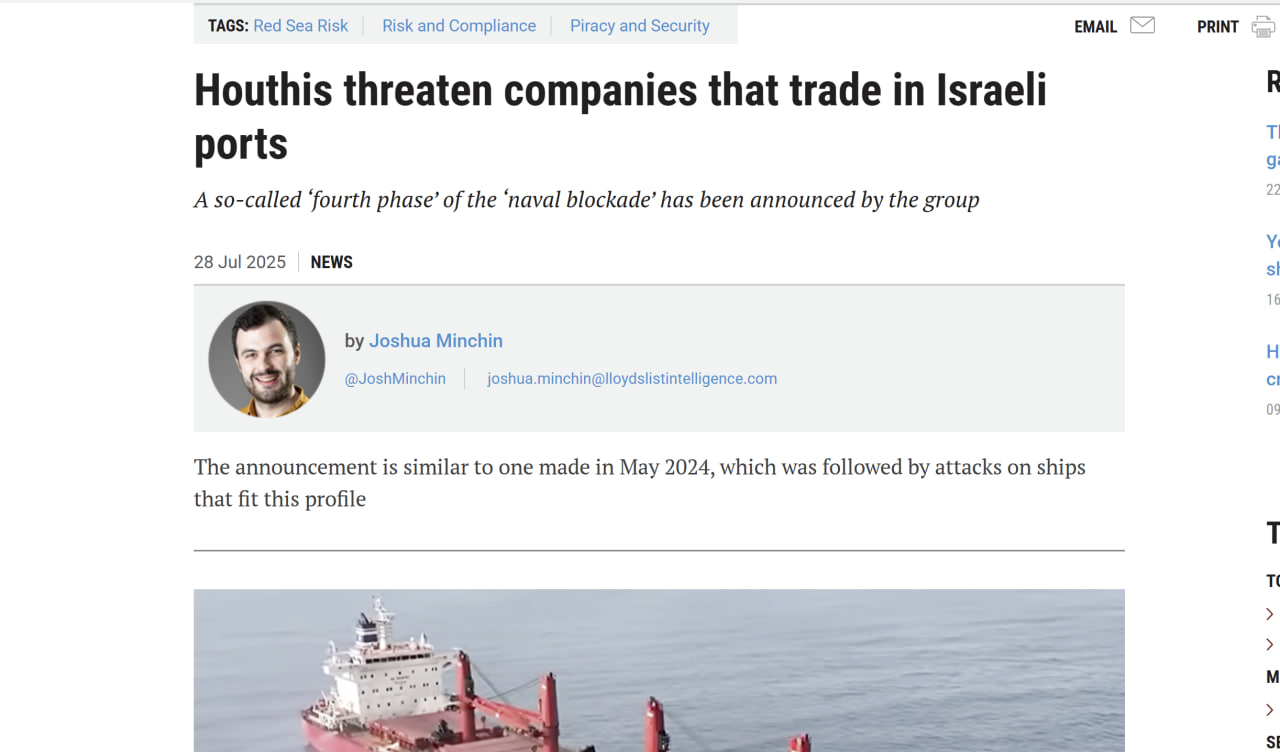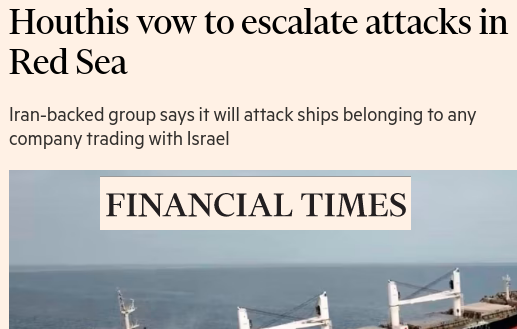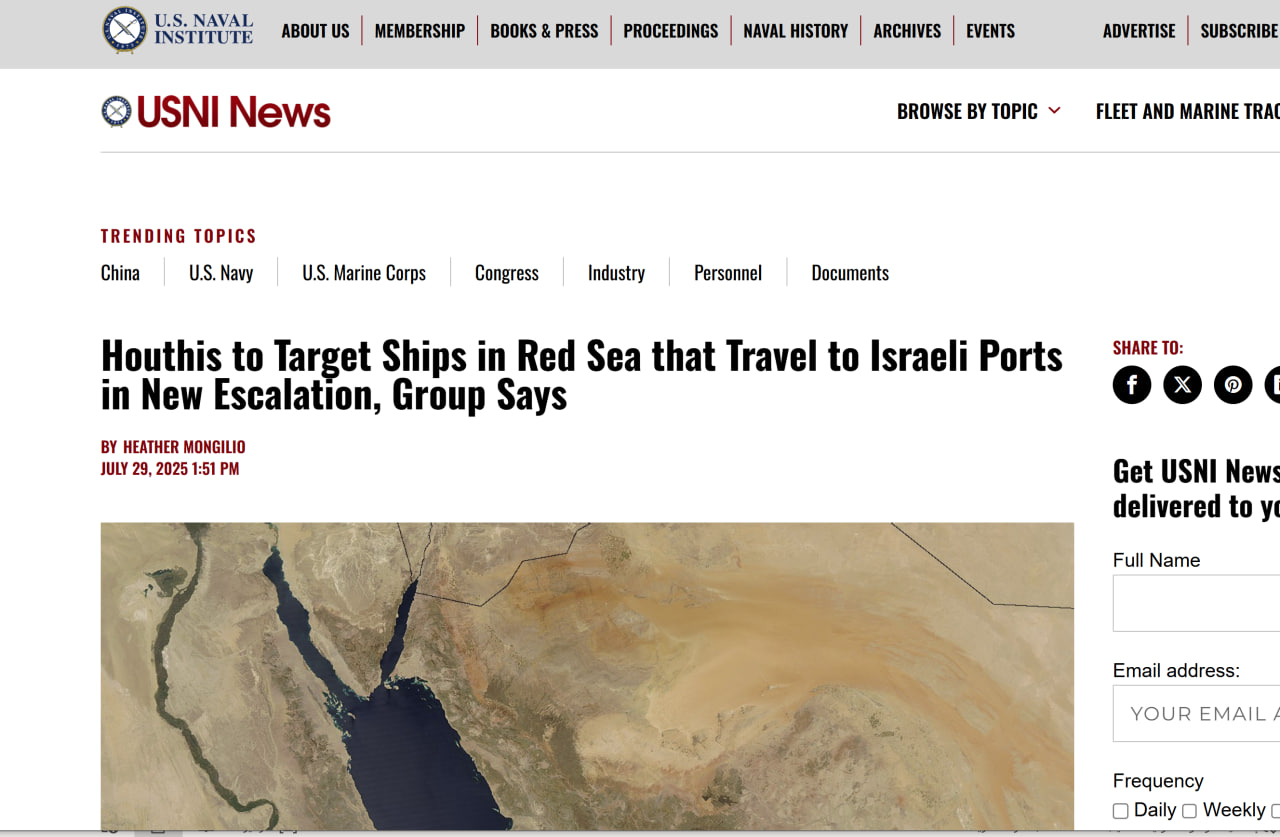Published: Safar 5, 1447 AH
The Zionist entity is facing escalating anxiety following the Yemeni Armed Forces’ announcement of the beginning of the fourth phase of the naval blockade. This phase targets any ships linked to the ports of the occupied Palestinian territories, whether through direct or indirect dealings. The announcement has sparked serious alarm within the political and military circles of the enemy, as growing assessments indicate that maritime traffic to and from the occupied ports will be further disrupted beyond the impact of previous phases.
According to a report published Wednesday by the Zionist “Israel News” website, the enemy entity has issued warnings to shipping operators, urging them to avoid navigating the Red Sea and the Arabian Sea, fearing new attacks by Yemeni forces. The report noted Yemen's renewed pledge to support the Palestinian cause and continue operations until the siege on Gaza is lifted and the aggression ceases.
The report stated that the new phase entails technical escalation in the weaponry used and an expansion in the geographical scope of the blockade. This development poses complex challenges for the occupation, challenges that cannot be resolved through military means or international pressure.
The site further indicated that Yemen’s latest move coincides with a clear American inability to impose maritime security in the region, particularly after the reduction of U.S. military presence in the Red Sea and the declining effectiveness of European naval operations.
Zionist analysts warned that if the blockade persists in its current form, it could lead to genuine economic paralysis at the occupied ports, especially given the refusal of several global shipping companies to conduct maritime routes to the entity. This highlights the growing economic challenges faced by the enemy due to the intensifying Yemeni naval blockade.

The Yemeni blockade’s effects on Israeli navigation go beyond military losses and the undermining of the prestige of Western arms. There are also massive economic costs incurred daily, deepening the financial crisis facing the Zionist enemy.
Zionist collected data confirms that the Yemeni blockade has driven up the cost of imports by more than $91 billion, in addition to over $50 billion in goods and services expenses. The blockade has imposed a difference of between $30 and $50 billion on the Zionist import bill, while insurance premiums have surged to $13 billion, reinforcing the notion that this fourth phase delivers a far more painful blow to the enemy.
The blockade has also caused major disruption to supply chains, increasing import/export durations to and from the occupied Palestinian ports. This adds financial strain, particularly after the shutdown of Umm al-Rashrash (Eilat) port and the halting of many critical activities. Although the enemy initially attempted to shift operations to Haifa and Asdud, the fourth phase has rendered those alternatives futile as shipping companies have refrained from dealing with ports in occupied Palestine. Many Zionist transport companies are now either bankrupt or on the brink of shutdown.
Following the Yemeni Armed Forces’ declaration of intent to target any ship linked to Zionist-affiliated companies — even if not headed to the occupied ports — the British maritime magazine Lloyd’s List warned of “growing fears within the global shipping market.” In a Tuesday report, the magazine described this threat as ushering in “a new phase of terror” in Red Sea navigation.
Martin Kelly, head of advisory at EOS Risk, noted that Yemeni forces are already implementing this strategy, citing the previous targeting of the oil tanker Magic Seas as proof of their seriousness.
Dirk Siebels, analyst at Risk Intelligence, urged ship operators to take Yemeni warnings extremely seriously, warning that ignoring them could result in “severe losses.” He recalled the targeting and sinking of both the Magic Seas and Infinity C tankers after they ignored the Yemeni-imposed blockade over Zionist atrocities in Gaza.

The military statement issued by the Yemeni Armed Forces on Sunday, July 28, 2025, marks a decisive turning point in the maritime conflict in the Red Sea and beyond. According to The Financial Times, the announcement reflects a “shift in intentions,” quoting EOS Group’s Martin Kelly as saying, “I believe we may see some attacks in the near future.”
Kelly noted that the statement's implications — suggesting attacks on ships linked to any state supporting the occupation — may signal Yemen’s readiness to end the ceasefire with Washington and resume targeting U.S.-affiliated vessels.
A maritime security expert interviewed by the newspaper argued that the ongoing situation in Gaza and continued Israeli violations against civilians have created an international “cover” granting Yemen additional legitimacy to continue its strikes. “With the global outrage over what’s happening in Gaza, it is likely the Houthis will capitalize on it to broaden their operations,” the expert added.

For the first time in decades of U.S. dominance in the Red Sea, the USNI News, affiliated with the U.S. Naval Institute, has revealed the complete absence of U.S. destroyers from the Red Sea. The site reported that since last week, not a single American destroyer has remained deployed there.
The entry of Yemeni forces into this new escalation phase against Zionist-linked vessels was described as “the most dangerous escalation since the start of Yemeni maritime attacks in November 2023.”
The report confirmed that Washington no longer maintains any direct military presence in the Red Sea, highlighting a stark decline in America’s deterrent capacity. It added that past operations — including the sinking of Eternity C and Magic Seas — were clear indicators of a qualitative shift in the Yemeni navy’s military and operational capabilities.
According to the report, Eternity C was sunk by the Yemeni navy after a 16-hour battle without any military aid from the U.S. or allied forces. The rescue was instead carried out by a commercial vessel, further evidencing the complete absence of American naval forces — a stark contrast to the former days of U.S. naval dominance.
Quoting prominent analysts, including Afshon Ostovar, the site stated that the absence of U.S. ships has granted Yemeni forces a more favorable environment for operations and enhanced their ability to execute effective strikes without fear of direct retaliation.
The report warned that Yemeni attacks have evolved beyond merely disrupting Zionist navigation, becoming a sophisticated training model that boosts Yemeni naval warfare proficiency in real-world conditions while testing international response thresholds.
It emphasized that Yemen does not aim to attack every ship but rather enough to maintain credible deterrence, and is clearly prepared to bear the consequences, as it has previously done in the face of U.S. and Israeli air raids.
The U.S. Naval Institute concluded that the Yemeni navy now holds the initiative in the Red Sea amid the absence of the U.S. fleet and the collapse of coordinated international response. Yemen is effectively redrawing maritime and sovereignty maps from the gateway of Gaza, as the world stands paralyzed before this unfolding geopolitical shift.

Despite ongoing siege and economic and military aggression, Yemen has managed to develop advanced missile systems and drones that have helped reshape regional power dynamics.
A report by the British newspaper The Sun highlighted Yemen’s military capabilities built over recent years, which have confounded Washington, Tel Aviv, and Europe alike. The report stated that Yemeni military operations in the Red Sea, Arabian Sea, and Bab al-Mandab — carried out in support of Gaza — have disrupted commercial activity at Zionist ports, particularly after Yemen’s effective blockade paralyzed and ultimately shut down Umm al-Rashrash (Eilat) port.
The report emphasized the failure of the United States, Israel, and the European Union to break Yemeni resolve, despite all military offensives, economic sanctions, and political pressures. Instead, Yemen succeeded in imposing new deterrence equations in the Red Sea.
The hesitant and partial responses from the U.S. and Zionist enemy reflect growing confusion and concern over the rising Yemeni military power, which is redefining the rules of engagement and posing serious challenges to the American project in the region. The report concluded that the battle in the Red Sea now stands as a clear model of Yemen’s resilience and its capacity to confront major challenges despite ongoing siege and international pressure.
In its coverage of the Yemeni Armed Forces' announcement of the fourth phase of the blockade, American maritime magazine The Maritime Executive published a report titled “The Houthis’ Ambitions Have Not Faded”, stating that the Houthis remain a fighting force, and their resolve to combat Israel for the sake of Palestine remains unwavering.
The report affirmed that Yemeni forces maintain high combat morale despite months of heavy U.S. and Israeli strikes. While the Zionist military finds itself facing an unconventional adversary without fixed bases or visible targets, the report noted that "Israel" is currently reassessing the threat coming from Yemen.
Zionist journalist Yoni Ben Menachem emphasized that the lack of permanent military bases or sensitive facilities in Yemen, coupled with the effectiveness of Sana’a’s security apparatus, has rendered all Israeli retaliatory efforts akin to internal confusion without any operational achievements.
Domestically, The Maritime Executive underscored the political strength of Sana’a, its sophisticated and efficient security apparatus, and its capacity to thwart any internal infiltration attempts — all of which reflect Yemen’s rising influence in the regional balance of power.








